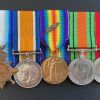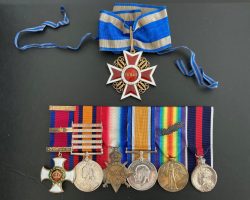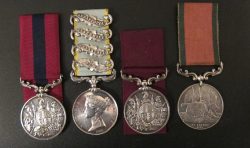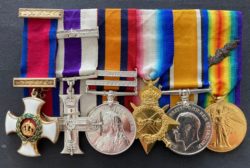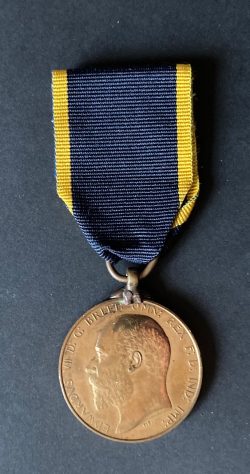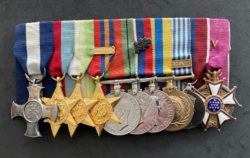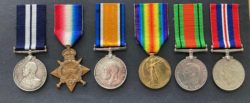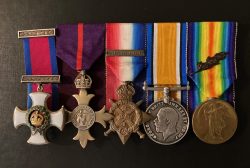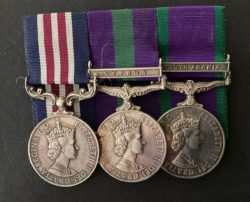The superb early Great War 10 Victory Ace Military Cross group of nine to Lieut. later Squadron Leader , Royal Warwick Regiment and 48 Squadron Royal Flying Corps all scored within in “Bloody April 1917”, a time when ‘victories were hard won, his first 7 as Observer to Capt. A.M. Wilkinson, D.S.O. and Bar. (19 Victories). With Wilkinson was one of two damaged aircraft that survived the first offensive patrol of the new Bristol fighter under Leefe-Robinson, V.C., when fallen on by Richtofen’s Flying Circus, Richtofen himself destroying 2 that day. Later served Iraq 1921 (MID). Twice wounded, GSW November, 1915 as Lieut. R. Warwicks and again May, 1917, GSW when with 48 Sqdn
£5,500.00
Out of stock
Military Cross (GV). Reverse engraved “L.W. Allen, R. War. R. & R.F.C. Arras 1917 Festner”; 1914/15 Star (Sjt. R. War. R.; British War Medal , Victory Medals , (Lieut. R.F.C.;), General Service Medal , clasp Iraq with M.I.D. oak leaf, (F/O R.A.F.), Defence Medal, War Medal, Air Efficiency Award (GV1) (Sqn. Ldr. R.A.F.) Special Constabulary Medal 9
GV) (Lawrence Allen)
Original Portrait Picture 8” x 6”, Photo Album good pictures of many flying Officers he served with, 11 pictures of Officer groups, himself and aerodromes he served on, letter re his wound from H.Q., R.F.C. And newspaper report of same.
Extensive file of copied research – Award Recommendation (with Capt. A.M. Wilkinson), Combat Reports, Service Papers, M.I.C., London Gazette’s, Casualty Card/forms, 48 Sqd article/history, etc.
Laurence Wilfred Allen,
23 Mar 1915 Sergeant R. War. R. (Flanders), 12 Jun 1915 WIA, GSW to arm, 20 Nov 1915 2.Lt. R. War. R., 5 Apr 1917 1st Victory against Manfred von Richtofen’s Jasta 11, 10 Apr 1917 promoted Flying Officer Observer and attached R.F.C., 24 May 1917 WIA, GSW to left buttocks, 26 May 1917 Military Cross, 16 Nov 1917 R.F.C. Invalided Board, noting GSW and Nightmares, repatriated to the UK, Allen then served at home as a Wing Instructor in Aerial Gunnery, 14 Dec 1917 Promoted Lieutenant, 1 Apr 1918 Lieutenant RAF, 24 Oct 1919 promoted Flying Officer from Pilot Officer, 28 Oct 1921- M.I.D. (Mesopotamia Expeditionary Force), 1 Sep 1922 Flying Officer, Class A, 30 Mar 1926 – Class C, 1 Sep 1926 Commission relinquished, 21 Mar 1939 Commissioned Pilot Officer, Special Duties Branch, 7 Apr 1941 Promoted Flight Lieutenant , 1 Jul 1943 promoted Squadron Leader, 11 May 1954 RAFVR, Squadron Leader retaining rank.
Military Cross (London Gazette 26/5/1917. 2nd Lt. (temp. Lt.) Laurence Wilfred Allen, R. War. R., attd. R.F.C.
“For conspicuous gallantry and devotion to duty when acting as an Observer. On many occasions he has helped to shoot down and destroy hostile machines. He has shown the greatest coolness and skill on all occasions, frequently clearing difficult jams in the middle of a fight.”
Mention in Despatches London Gazette 28/10/1921 Mesopotamian Expeditionary Force:— Flying Officer Laurence Wilfred Allen, M.C., R.A.F.
Laurence Wilfred Allen was born in Coventry 14 Sept 1892, the son of a Cycle Mechanic, of 83 Moor Street, Coventry.A pre-war volunteer, who enlisted as a Private (1377) in the 7th Battalion Royal Warwickshire Regiment (TF). He accompanied his Battalion to France and served in the Trenches as a Sergeant from 22 March 1915.
Picked out for Commission, he was Gazetted Second Lieutenant in the 6th Battalion Warwick Regt. on 20 November 1915. He continued service in the trenches until seconded to the R.F.C. late in 1916.
Laurence qualified as an Observer and was a “founding member” of 48 Squadron, equipped with the BF2a, transferring to Bertangles, France on 8 March 1917.
No. 48 Squadron of the Royal Flying Corps was formed at Netheravon, Wiltshire, on 15 April 1916. The squadron was posted to France in March 1917 and became the first fighter squadron to be equipped with the Bristol Fighter. It soon established itself as one of the premier fighter squadrons of the R.F.C. and later R.A.F. and pioneered the use of the two-seater fighter-reconnaissance type. The squadron was disbanded on 1 April 1920.
In the hectic period of “Bloody April”, April-June 1917, Allen claimed no less than 10 aerial victories. The first seven of his ten victories had him paired with Captain Alan Machin Wilkinson, D.S.O., an eventual 19 Victory Ace.
Wilkinson was awarded the D.S.O. 20 October 1916, by which time he had been ordered to the Home Establishment and on October 13th, he joined No. 48 Squadron. At this time the close of 1916, Wilkinson’s ten victories placed him second only to Albert Ball on the Aces list.
In early 1917, 48 Squadron became the first unit to be equipped with the new two-seater Bristol F2B fighter. The Squadron went to France in March 1917 and its command passed to Major ‘Zulu’ Bettington, who had as his flight commanders, Capt. A.M. Wilkinson, D.S.O., Captain D.M. Tidmarsh, M.C. another veteran of 24 Squadron, and Captain W. Leefe-Robinson, who had been awarded the Victoria Cross for the destruction of the German airship S.L.11 over North London on the night of 2/3 September 1916.
5 April 1917- 48 Squadrons first mission, but fatally Leefe-Robinson VC, who led the first patrol of the day, adopted entirely the wrong tactics by refusing to engage the enemy with the pilot’s front gun and leaving the work of defending the aircraft, if attacked, to the Observer. Also, Robinson ordered that the guns should not be lubricated to prevent the oil from freezing, causing the guns to jam regardless. Well over the lines, Leefe-Robinson’s patrol met five Albatross DIIIs of Manfred von Richthofen’s Jagdstaffel 11 in the Douai area, with disastrous consequences. Only two of the Bristol F2Bs, crewed by Capt. Wilkinson and Lieut. Allen and Lt. Pike and 2Lt. Griffith, limped home. In the next eleven days a further eight aircraft were lost before one or two pilots started to fly the two-seater aircraft like a single-seater fighting scout.
According to Manfred von Richtofen, who claimed his 35th and 36th victories in this engagement, “After the attack, which was similar to a Cavalry charge, the enemy squadron lay demolished on the ground. Not a single one of us was even wounded.”
The Bristol’s ‘black day’ was far from over and despite this catastrophe, Wilkinson and Tidmarsh led their Flights on patrols later in the day and both claimed victories without loss, thereby proving the Bristol F2A’s combat capabilities from the outset. For his part Wilkinson, with Lieutenant L.W. Allen as his Observer, shot down an Albatross D III out of control. ‘Zulu’ Bettington’s three-page recommendation for the Bar to Wilkinson’s D.S.O., states that he made his initial attack with the front gun, which unfortunately jammed, whereupon he dived steeply to give Allen the shot. Having begun this fight at 10,000 feet, Wilkinson carried it on down to 3,500 feet, by which time the Flight had driven down a total of 3 H.A.’s, and dispersed the rest.
“Bloody April” was to be a ferocious month of air fighting with Wilkinson being credited with at least nine victories, seven in the course of only four days and six in one day!
9 April 1917 was the day when Wilkinson destroyed a two-seater near Lens; drove down an Albatross two-seater out of control in the same vicinity; destroyed an Albatross D III near Arras; and drove down another Albatross D III out of control also near Arras. Having successfully despatched the first of these four victims, Wilkinson’s wing man was obliged to return to base owing to engine trouble, but Wilkinson ‘fully appreciating the importance of events taking place on the ground beneath him and knowing that he was being relied on by me (‘Zulu’ Bettington) to maintain a patrol, carried on alone. Very shortly afterwards finding three large 2-seater H.A. and being escorted by 3 fast Scouts much higher up, Capt. Wilkinson hung round skilfully keeping his own machine out of sight as much as possible by getting between the Artillery machines, the sun and clouds; waiting a favourable opportunity to attack this far superior number, an opportunity soon presented itself when a big cloud came over between the escorting Scouts and the artillery ranging machines, he dived among them from behind and both pilot and Observer opened fire; the attack being so sudden and swift none of the H.A. attempted to fight but dived hard, however Capt. Wilkinson dived equally fast getting a series of bursts of 100 rounds altogether into one at between 50 and 75 yards, which promptly went down hopelessly out of control; meanwhile the Observer Lieut. Allen brought his gun to bear on another enemy machine at 150 yards range sending the second down obviously hard hit. The third H.A. was not seen again; neither were the Scouts overhead when Capt. Wilkinson reappeared from under the cloud.’
On Wilkinson’s next patrol on the same day, when only one other Bristol remained with him, two more H.A. were spotted and attacked. Wilkinson selected the lower of these two and then swiftly turned up on the other giving Allen a favourable shot at 10 yards. But unfortunately Allen’s gun jammed. One of the H.A. then fastened on to the tail of the other Bristol, damaged it and at some point killed the Observer (Lt. H.G. Collins). Wilkinson immediately swung his machine so as to allow Allen, who had cleared the previous jam, the chance to drive the H.A. away from the stricken Bristol. Having fired a burst from 30 yards as he passed across the H.A.’s bows, Wilkinson was attacked by another enemy machine into which Allen pumped the best part of a drum and a half, causing it to fall away out of control. The other Bristol was still receiving the unwelcome attentions of the enemy, and Wilkinson, his own gun now jammed, again manoeuvred to give Allen a shot. After a good burst from Allen the H.A. attacking Wilkinson’s partner was seen to drop away out of control, just as Allen’s gun jammed again. Wilkinson put his machine into a vertical spiral, while Allen with exemplary calmness attempted to rectify the problem. Then a third H.A., realizing their difficulty, endeavoured to latch on to their tail, firing bursts all the time. Once Allen had fixed the gun he signalled to Wilkinson who immediately assumed the offensive. The H.A. banked and an accurate fire from Wilkinson’s Bristol at 15 yards range sent it earthward Out of Control.
The above account, credits Wilkinson with six victories, (and Allen with two victories) on 9 April, 1917, supported by the official citation for the award of his Bar to the D.S.O., which stated ‘In one day he shot down and destroyed six hostile machines’. Being the first Commonwealth pilot to destroy six E.A. in one day.
R.F.C. Communique 83, 8-14 April 1917 “48 Sqn. destroyed a hostile machine East of Arras. Capt. A.M. Wilkinson and Lieut. L.W. Allen, Lts. J.H. Letts and H.G. Collins, in two machines of 48 Squadron, attacked five hostile aircraft near Arras. They destroyed one and drove another down out of control.”
12 April 1917 Flying again with Lieutenant Allen, who took part in all Wilkinson’s subsequent victories and ultimately ended the war with 10 Observer/Gunner victories, he shared the credit in driving down out of control one of a flight of seven Albatrosses with 2/Lts. Winckler and Moore.
R.F.C. Communique 83, 8-14 April 1917 “Capt. A.M. Wilkinson and Lieut. L.W. Allen, 2Lts. W.O.D. Winkler and E.S. Moore, 48 Squadron, drove down out of control one of seven hostile machines they encountered.”
13 April 1917 On an evening patrol, Wilkinson and Allen destroyed another Albatross when about twenty HA were engaged near Vitry-en-Artois. In the same combat they also shared in a victory brought about through the combined efforts of themselves, Lieut. Warren and his Observer, 2nd Lieut. Davies.
R.F.C. Communique 83, 8-14 April 1917 “On the evening of the 13th a patrol of 48 Squadron engaged about 20 hostile aircraft near Vitry-en-Artois. One HA was destroyed by Capt. A.M. Wilkinson and Lieut. L.W. Allen, and a second was driven down completely Out of Control by Lt. Warren and 2Lt. Griffith.”
22 April 1917 Wilkinson and Allen engaged fourteen HA and sent an Albatross down OOC, Wilkinson’s last victory before being transferred to Command 23 Sqn.
In its first 26 days of operation, 48 Squadron had lost a total of 11 Aircraft, 24 Aircrew KIA or POW, 2 WIA, while claiming 9 HA Destroyed, 18 Out of Control and 13 Driven Down.
12 May 1917 7.30pm Capt. J.H. Letts and Lieut. L.W. Allen in BF2a A7106 sent and Albatross DIII down OOC. Their combat report states action against 6 Albatros scouts and 1 Albatros two-seater. “Whilst leading a C.O.P. Pilot followed a single British machine who was attacked by 1 H.A., Pilot dived, firing Vickers, and drove H.A. East away from British machine which went West.
Observer engaged Albatros scout firing full drum into him at 150 yards. H.A. was observed to fall out of control.
Observer then engaged another Albatros directly overhead. H.A. dived steeply away due East. Pilot engaged another H.A. who went East. Observer then engaged three more H.A. at various ranges with no apparent result. Engagement lasted10-15 minutes.”
Comment by C.O. “1 E.A. driven down Out of Control. Others driven East. This is in all probability the unidentified machine seen to crash by A.A. in C9 or C16. The fight took place over IZEL with 6 Albatros scouts. If this is so it would also account for A.A. Only seeing 5 scouts.”
24 May 1917 while flying with Captain J.H. Letts again, in BF2a A3350, Allen was involved in a fierce combat against four enemy two-seater machines. Despite the heavy odds they claimed two aircraft destroyed while driving the other two off. Their aircraft was damaged during the fight and in this combat they are officially credited with one victory. Although Letts escaped injury, Allen was WIA. Casualty report states “Driving off E.A. – Wounded in head.”
R.F.C. Communique 89, 20-25 May 1917 “Capt. J.H. Letts and Lieut. L.W. Allen, 48 Squadron, engaged four enemy two-seater HA. One was driven down out of control and a second badly damaged. The other two fled.”
16 June 1917-Flying F2B A7107 Lt. Curtis and 2Lieut. Allen destroyed an Albatross DIII, Allen’s 10th victory.
At 7 July, 48 Squadron had lost totals of 2 Aircraft, 4 Aircrew while claiming 9 HA Destroyed, and 11 OOC. In Summary for the 94 day period between 5 April – 7 July 1917, 48 Squadron had suffered overall totals of 17 Aircraft, 36 Aircrew KIA or MIA, 13 WIA (including Lieut. Allen), while claiming 93 HA Destroyed/OOC/or DD.
Aerial Victories, all in 48 Squadron.
1) 05 Apr 1917 p.m., Bristol F.2a, Albatros D.III (Out of Control), Douai.
2) 09 Apr 1917 p.m., Bristol F.2a, Albatros D.III (Destroyed), E of Arras.
3) 09 Apr 1917 p.m., Bristol F.2a, Albatros D.III (Out of Control), E of Arras.
4) 12 Apr 1917, Bristol F.2a, Albatros D.III (Out of Control).
5) 13 Apr 1917 p.m., Bristol F.2a, Albatros D.III (Destroyed), Vitry-en-Artois.
6) 13 Apr 1917 p.m., Bristol F.2a, Albatros D.III (Out of Control), Vitry-en-Atrois.
7) 22 Apr 1917, Bristol F.2a, Albatros D.III (Out of Control), Vitry-en-Artois.
8) 12 May 1917, 19.30, Bristol F.2b (A7106), Albatros D.III (Out of Control), Izel.
9) 24 May 1917, 1515, Bristol F.2b (A3350), Two-seater (Out of Control), Vitry.
10) 16 Jun 1917, 0730, Bristol F.2b (A7107), Albatros D.III (Destroyed), Fresnes-les-Montauban.
Allen subsequently undertook Pilot training in the post-War/post – Mesopotamia years, and on 1 September 1922 he became a Class ‘A’ Reservist in the RAF.
2-10 January 1924, Armstrong-Whitworth Civilian Flying School, on a Whitley “A careful and steady pilot, experienced in two seater fighting.”
16-24 June 1924 “A good, steady pilot, will improve with confidence. Lacks confidence in Cross-country flying.”
18-23 July 1924 “A keen, reliable pilot, good in the air. Approaches and landing not quite so good as during the last course.”
3-10 March 1925 AT Complete. Required the normal amount of dual. Appears at times to lack confidence, but flying is reliable, should improve with practise.”
17 February 1926 Suspended. Whilst flying one of only six Armstrong-Whitworth Wolf aircraft (G-EDHJ), he was injured during a crash at Whitley Aerodrome. It is noted that “This Officers flying has deteriorated considerably. He appears to have lost his confidence.”
His grading dropped to ‘C’ Class on 30 March 1926.
The Armstrong-Whitworth Wolf was a two-bay biplane of unorthodox design, with the fuselage mounted between the two sets of wings. No production order was placed, and the three machines built served their days at the Royal Aircraft Establishment at Farnborough as experimental test beds.
Alongside the RAF’s order in 1923, Armstrong Whitworth also built two for the RAF Reserve Flying School at Whitley, and a final, sixth aircraft in 1929. As trainers, they proved popular with pilots, although less so with ground crews for whom the rigging and undercarriage were awkward to maintain. All Wolves were retired from service in 1931. Only 6 built in total.
Allen relinquished his commission in the Reserves on 1 September 1926.
Allen served in WW2, 1939-54, attaining the rank of Squadron Leader, Possible Flying Instructing in Canada.
Iraq Command was the R.A.F. commanded inter-service command in charge of British forces in Iraq in the 1920s and early 1930s, during the period of the British Mandate of Mesopotamia. It continued as British Forces in Iraq until 1941 when it was replaced by AHQ Iraq.
Following the end of World War I and the accompanying British defence cuts, the new R.A.F. took up the task of policing the Empire from the air. In May 1920 an insurgency broke out around the Euphrates and this uprising rapidly extended it to a more general area. The Air Officer Commanding the Middle East dispatched an additional squadron from Egypt to Iraq. In London the Government were seeking a solution and the Army’s proposal, which involved reinforcing Iraq with large numbers of personnel, was considered to be too expensive by the Cabinet. Churchill, remembering the RAF’s success in Somaliland asked Trenchard for a cheaper alternative and a plan for air control using air power as a more cost-effective way of controlling large areas than by using conventional land forces was proposed. In Mesopotamia there was a need to counter Turkish aspirations and by 1920 a Mesopotamian Wing had been established. In January 1921 Mesopotamian Group was formed by raising Mesopotamian Wing to group status and on 1 October 1922 Mesopotamian Group was absorbed into the newly formed Iraq Command which was given control of all British forces in Iraq.
1920 to 1922 – The Great Iraqi Revolution of 1920 started in Baghdad in the summer of 1920 and lasted until 1922.
No. 6 Sqn RAF, following the Armistice the squadron transferred to Iraq, arriving in July 1919. Operating in the Army Co-operation role in Northern Iraq, it was equipped with Bristol Fighters, the Squadron remained there for ten years before moving to Egypt in 1929.
No.14 Sqn. – Reformed in Palestine a year later, the Squadron remained in the region throughout the Inter-War years, flying Bristol Fighters and on various duties including air policing, photo survey and many long-distance ‘flag waving’ flights around the region.
N0. 30 Sqn, February 1920 saw the Squadron returned to full strength with the arrival of DH9s and RE8s equipped for the day bomber role. For the next 20 years, No. 30 Squadron remained in Iraq before moving to Egypt.
